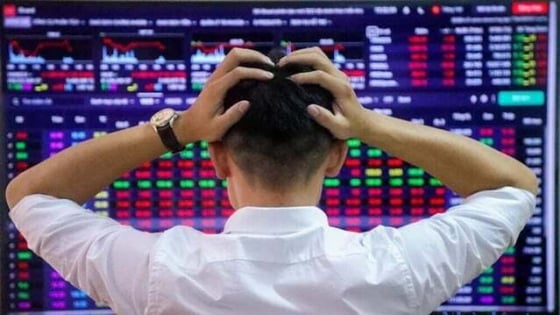By
My Ha, Thai Ha
Mon, October 20, 2025 | 5:49 pm GMT+7
VN-Index, which represents the Ho Chi Minh Stock Exchange (HoSE), saw the sharpest decline in its 25-year history on Monday, down by 94.76 points, or 5.47%, to 1,636.43.
Selling pressure overwhelmed the market. On the HoSE, 325 stocks declined, of which 108 hit the floor price, while only 34 stocks rose.
The VN-Index plunged by 94.76 points, or 5.47%, to 1,636.43 points on October 20, 2025. Photo by The Investor/Trong Hieu.
The VN30 group, which comprises 30 largest-cap stocks, fell by 106.28 points (5.38%) to 1,870.86, with all the stocks dropping and 13 hitting the floor, including GVR, HDB, HPG, MBB, MSN, SHB, SSI, STB, TCB, and TPB.
Bottom-fishing demand drove liquidity sharply higher to VND53,300 billion ($2.02 billion) on the HoSE alone – the highest in a month – but it was still insufficient to offset the heavy selling. Many stocks remained at floor prices with large sell orders unfilled.
Nguyen Minh Hoang, director of analysis at Nhat Viet Securities (VFS), told The Investor that certain information about bond inspection results at several major conglomerates such as Masan and Novaland, released late last week, triggered floor-price drops and sparked a wave of panic selling across the market.
Hoang noted that the stock market had enjoyed a prolonged rally since April (following the U.S. tariff incident), with the VN-Index climbing from around 1,090 to nearly 1,800 points. Excluding the contribution of the Vingroup group, the market still posted significant gains, with many stocks doubling in price. During that run, the market had not experienced a meaningful correction, so this could be considered a normal shakeout.
He drew parallels with the 2020-2021 period, when the market fell sharply in March 2020 due to the Covid-19 outbreak but then surged for the next 9-10 months. After nearly a year of continuous gains, selling pressure built up and only a small trigger was enough to cause a short correction. In January 2021, the VN-Index dropped around 200 points over 4-5 sessions before resuming its uptrend.
In the current context, the VFS expert believes that the market’s fundamentals remain intact, supported by economic growth and ongoing government stimulus policies. Meanwhile, the side effects of these policies – such as inflation and exchange rate pressure – remain under control.
From a valuation perspective, before Q3 earnings results were released and amid the strong rally, the market’s P/E ratio had already risen above 16, surpassing the 5-10 year average. Therefore, Vietnamese equities are no longer cheap, and a correction is necessary for a healthier next leg up. The current decline, coupled with improved Q3 profits, may help valuations become more attractive and set the stage for a stronger rebound.
“In my view, we should remain confident in the medium- and long-term prospects. The Vietnamese stock market still has major upcoming stories – the market status upgrade and IPOs of large enterprises,” Hoang emphasized.
A buying opportunity
The VFS analysis director advised investors to recall that when large-cap stocks like Vingroup or banks kept pushing the VN-Index to new highs, many were too afraid to buy. Now that the market has corrected, they are still hesitant. “If you don’t buy when it’s up and don’t buy when it’s down, you’ll never invest,” he remarked.
Therefore, during this correction phase, investors should reassess whether the medium- and long-term trends remain intact. If the overall trend is still strong, this is an opportunity rather than a risk – especially for those holding cash. Investors should stay calm, observe the market like professionals, and look for reasonable entry points instead of panicking.
Given the current strong selling momentum, Hoang expects the correction to continue at least until the morning session of Tuesday, October 21. Investors should monitor key support levels – around 1,600 points or 1,550-1,560 points – to see if buying demand returns. If it does, investors could gradually deploy capital into potential stocks.
Nguyen Trong Dinh Tam, deputy director of analysis at ASEAN Securities, commented that investors should get used to volatility. He recalled that during the 2021 bull run, sharp corrections like the one on Monday also occurred. “Deep declines are always opportunities, even major ones, to open margin positions,” he said.
According to Tam, after the shakeout, the VN-Index will likely continue its upward trajectory formed since Q2/2025, supported by ongoing macroeconomic resilience and qualitative improvements in the market structure tied to the market status upgrade story.


